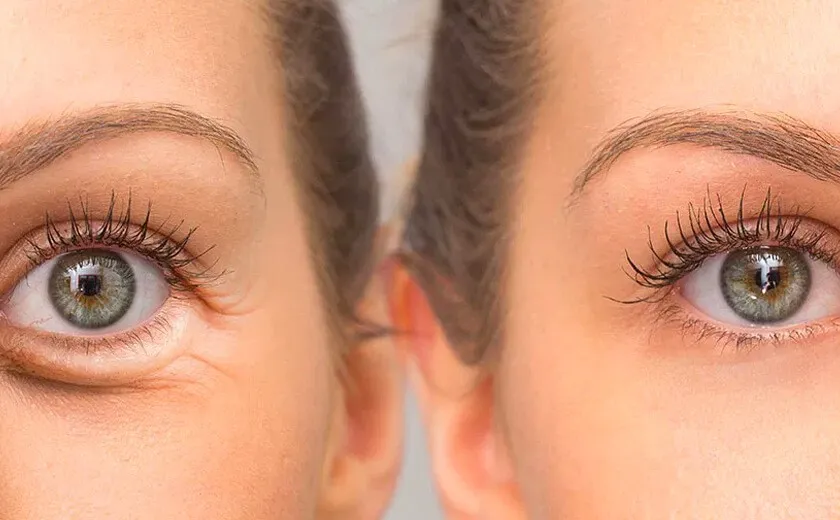Surgical intervention around the eyes
Surgical intervention around the eyes can be considered for two reasons. Firstly, for aesthetic reasons such as eyelid edge wrinkles that create a tired, sleepless appearance, bagging in the eyelids, or wrinkles and sagging in the eyelids; secondly, for functional reasons in cases where ptosis, i.e., drooping of the upper eyelid, or sagging of the eyelids impairs vision, or when the eyelid anatomy is disrupted due to burns, accidents, or cuts, affecting eyelid functions.
Crow’s feet, also known as light eyelid edge wrinkles, can be treated with non-surgical methods. Injection of botulinum toxin into the skin temporarily paralyzes the nerve that moves that area, preventing the expressions that cause wrinkles, and very successful results are obtained temporarily with a simple injection without the need for surgery. Sometimes it may be necessary to repeat the botulinum toxin injection.
The eyelids are curtains made of skin, muscle, and fibro-elastic layers, located in front of the eyeball and covering the base of the orbit, serving to protect the eye from excessive light and external influences.
When the free edges of the upper and lower eyelids touch each other or move apart, the front part of the eyeball is covered or revealed. These movements are referred to as the opening and closing of the eye.
The upper eyelid is larger than the lower eyelid, and it is only this lid that moves up and down during the opening and closing of the eye. When the eye is open, the lower eyelid is located 1-2 mm below the lower edge of the cornea, while the upper eyelid extends slightly over the top of the cornea, about 1 mm. When the eye closes, the lower eyelid rises to the lower edge of the cornea; the upper eyelid moves downward from above, covering the entire cornea.
Blepharoptosis, characterized by drooping of the upper eyelid and the inability to sufficiently lift the affected eyelid, is a fairly common pathology that concerns both plastic and reconstructive surgery, as well as ophthalmology.
In blepharoptosis, the normal eyelid gap of 8-10 mm is narrowed. The ptotic upper eyelid not only disrupts the appearance of the person’s face, which is important from an aesthetic standpoint, but in severe cases, it also covers the visual axis, creating significant problems for vision. Particularly in children, a ptotic upper eyelid that covers the visual axis can lead to deprivation amblyopia.
Surgical treatment plays an important role in cases of blepharoptosis to maintain normal eye function and achieve a symmetrical appearance. However, in this condition, where many surgical techniques have been tried, and new techniques are still being published, an optimal method has not yet been determined.
The eyes, being the most advanced organ in the body in terms of aesthetics and function, hold a significant place in surgical treatment for maintaining normal eye function and achieving symmetrical appearances in cases of blepharoptosis. The goal of ptosis surgery is to lift the drooping eyelid and create a well-defined eyelid crease to achieve the closest possible cosmetic result to perfection. Despite advancements in surgical techniques, predicting the postoperative outcome in some ptosis cases can be challenging. Sometimes, postoperative revision may be necessary. There is no single method that can correct ptosis in all cases. While the primary aim is to correct ptosis, it’s essential to consider the eye’s protective mechanisms and etiological factors when deciding on surgery.


Complications in ptosis surgery can arise due to incorrect surgical choices and technical errors. Therefore, the most appropriate surgical technique should be selected based on the type of ptosis, the degree of ptosis, levator function, and other characteristics of the cases. From a surgical perspective, it’s advisable to choose techniques that the surgeon is most experienced with, and if necessary, methods that allow for a second operation. Easy and effective methods should be preferred.
In cases of bilateral severe ptosis, the head is tilted backward to open the visual axis, and the frontalis muscle is used to lift the eyelid, causing the eyebrows to be raised. As a result, horizontal wrinkles may develop on the forehead and vertical wrinkles may appear at the root of the nose.
In light of all this, when it comes to eyelid procedures, whether they should be performed by a plastic surgeon or an eye doctor, the answer should be an oculoplastic surgeon. Whether they are a specialist in aesthetic and plastic surgery or an ophthalmologist, they should be a surgeon who has specifically studied eyelid and periocular diseases and anatomy and has experience in this field.

Create an Online Appointment
You can easily create an appointment by filling out the appointment form below or by clicking here to contact us via Whatsapp.